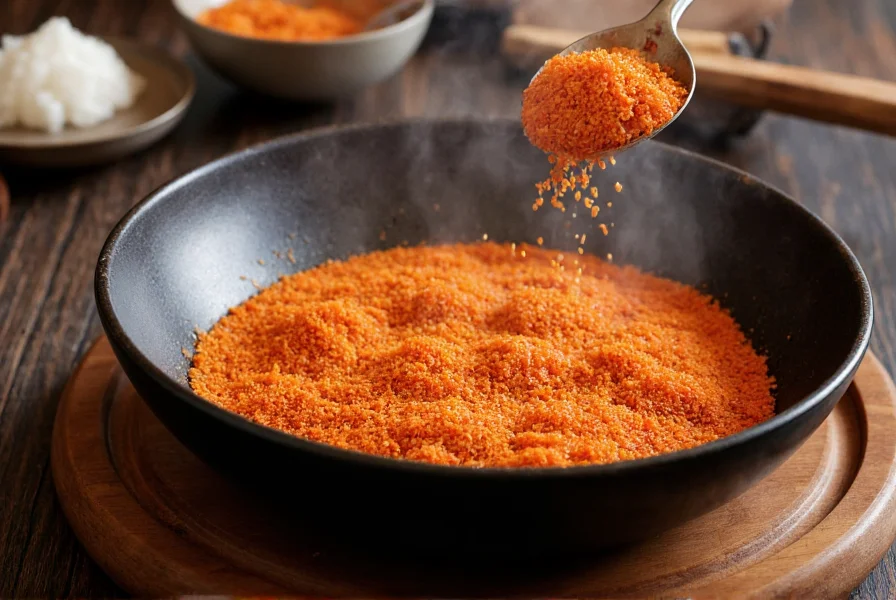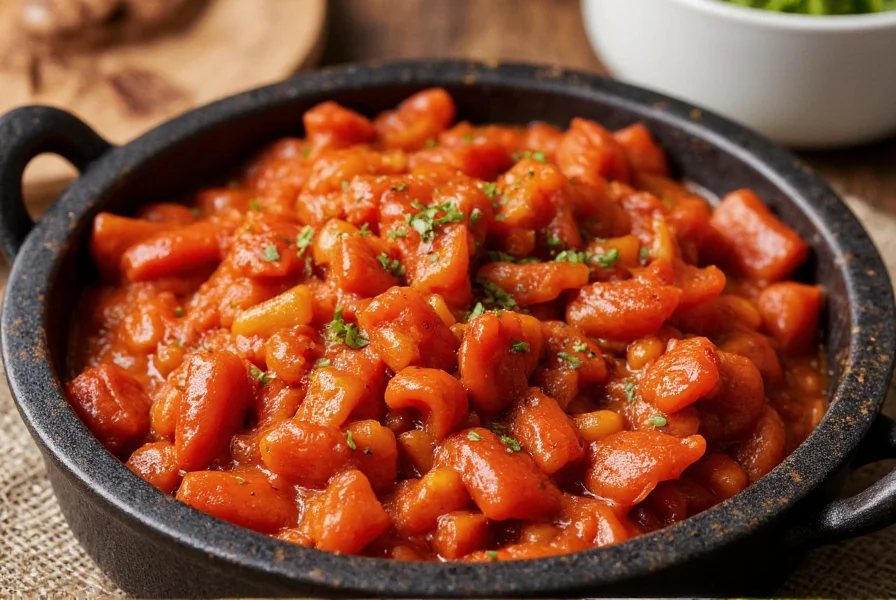Korean chili isn't a single variety but rather encompasses several specific pepper types cultivated in Korea for centuries. The most common form encountered outside Korea is gochugaru, the dried and ground red pepper that gives Korean dishes their signature color and flavor. Understanding Korean chili requires distinguishing between the fresh peppers, the flakes, and the paste forms that each play unique roles in Korean cooking.
Understanding Korean Chili Varieties
Korean cuisine utilizes several distinct chili varieties, each serving specific culinary purposes:
| Variety | Form | Heat Level (Scoville) | Primary Culinary Use |
|---|---|---|---|
| "Cheongyang" pepper | Fresh or dried | 8,000-10,000 | Kimchi, stews, fresh preparations |
| "Taewhango" pepper | Dried (coarse flakes) | 4,000-6,000 | Traditional kimchi making |
| Gochugaru | Medium-fine powder | 3,000-8,000 | Most Korean dishes requiring chili |
| Gochujang | Thick fermented paste | Varies (typically 1,500-3,000) | Marinades, sauces, dipping condiments |
What Makes Korean Chili Unique
The distinctive characteristics of Korean chili set it apart from other global varieties. Unlike Thai bird's eye chilies known for intense heat or Mexican guajillo peppers valued for smokiness, Korean chili delivers a balanced flavor profile where heat plays a supporting role rather than dominating the dish.
Gochugaru specifically undergoes a careful sun-drying process that develops its signature sweet-smoky notes. The traditional method involves spreading harvested peppers on mats in direct sunlight for several days, turning them regularly until completely dry. This slow drying preserves natural sugars while developing complex flavor compounds that industrial drying methods often miss.

Culinary Applications of Korean Chili
Korean chili serves as the flavor foundation for countless traditional dishes. Its applications extend far beyond simple heat provision:
- Kimchi preparation - The coarse variety of gochugaru provides texture and gradual flavor release during fermentation
- Gochujang production - Korean chili powder combines with fermented soybeans and glutinous rice to create this essential paste
- Stews and soups - Adds depth and color to dishes like budae jjigae and kimchi jjigae
- Marinades - The sweet-heat profile complements meats exceptionally well
- Seasoning blends - Combined with sesame oil, garlic, and other ingredients for finishing dishes
Professional Korean chefs emphasize that the quality of gochugaru directly impacts the final dish. Premium varieties show a vibrant crimson color rather than dull red or brownish tones, indicating proper drying and freshness. The texture should be consistent—neither too fine like cayenne nor too coarse with large pepper fragments.
Comparing Korean Chili to Other Varieties
Understanding how Korean chili differs from other global varieties helps home cooks make informed substitutions when necessary:
- vs Thai chilies - Korean chili offers less intense heat with more sweetness and less floral notes
- vs Mexican chilies - Ancho or guajillo peppers provide smokiness but lack the distinctive fruitiness of Korean varieties
- vs Chinese chilies - Sichuan peppers focus on numbing sensation rather than the balanced heat-sweetness of Korean chili
- vs Hungarian paprika - While similar in color, paprika lacks the complex flavor profile and has significantly less heat
When authentic Korean chili isn't available, the closest substitute combines mild paprika (for color and sweetness) with a small amount of cayenne (for heat). However, this approximation misses the nuanced flavor that makes Korean dishes distinctive.
Proper Storage and Handling Techniques
To maintain the quality of Korean chili products, proper storage is essential. Gochugaru and gochujang should be kept in airtight containers away from light and moisture. Refrigeration extends the shelf life of opened packages significantly—up to six months for gochugaru and one year for gochujang.
When working with Korean chili flakes, many Korean home cooks recommend blooming them in a small amount of oil before adding to dishes. This technique, called "toasting," enhances the natural flavors and integrates the chili more thoroughly into sauces and stews. Simply heat 1-2 tablespoons of neutral oil in a pan, add the gochugaru, and stir for 30-60 seconds until fragrant before incorporating into your recipe.

Common Misconceptions About Korean Chili
Several misconceptions persist about Korean chili that affect how people use it:
- Misconception: All Korean chili is extremely hot
Reality: Most Korean chili varieties fall in the medium heat range, with emphasis on flavor rather than pure heat - Misconception: Gochugaru and gochujang are interchangeable
Reality: They serve different purposes—gochugaru provides immediate flavor while gochujang offers fermented complexity - Misconception: Korean chili is just like cayenne pepper
Reality: Cayenne is significantly hotter with a one-dimensional heat profile lacking the sweetness of Korean varieties
Understanding these distinctions helps cooks use Korean chili more effectively in both traditional and fusion recipes. The versatility of Korean chili extends beyond Korean cuisine—it can enhance marinades, rubs, and sauces in various culinary traditions when used thoughtfully.
Frequently Asked Questions
What is the difference between gochugaru and regular chili powder?
Gochugaru is made from specific Korean chili varieties that offer a unique balance of moderate heat (3,000-8,000 Scoville units), sweetness, and subtle smokiness. Regular chili powder typically contains cayenne pepper as its primary ingredient, resulting in significantly more heat with less complexity. Gochugaru also has a distinctive vibrant red color that regular chili powder lacks.
Can I substitute paprika for Korean chili flakes in kimchi?
You can create a reasonable approximation by combining 3 parts sweet paprika with 1 part cayenne pepper, but the result won't capture the authentic flavor. Traditional kimchi relies on the specific characteristics of Korean chili varieties, particularly their natural sweetness and moderate heat that allows fermentation to develop properly. For best results, seek authentic gochugaru from Korean markets or reputable online retailers specializing in Korean ingredients.
Why does my gochugaru taste bitter?
Bitterness in gochugaru usually indicates improper storage (exposure to moisture or light) or that the product has passed its prime. Authentic Korean chili flakes should have a sweet, slightly smoky aroma with moderate heat. If your gochugaru tastes bitter, it's likely oxidized or contaminated. Properly stored in an airtight container in the refrigerator, gochugaru maintains quality for 6-12 months.
Is Korean chili the same as Sichuan pepper?
No, Korean chili and Sichuan pepper are completely different. Korean chili (gochugaru) comes from Capsicum annuum varieties and provides heat and color. Sichuan pepper comes from the Zanthoxylum plant family and creates a distinctive numbing sensation (ma la) without significant heat. They serve different purposes in their respective cuisines and are not interchangeable.
How spicy is traditional Korean chili compared to other peppers?
Traditional Korean chili (gochugaru) ranges from 3,000-8,000 Scoville Heat Units, placing it in the medium heat category. For comparison: bell peppers are 0 SHU, jalapeños are 2,500-8,000 SHU, Thai bird's eye chilies are 50,000-100,000 SHU, and habaneros are 100,000-350,000 SHU. Korean cuisine emphasizes flavor balance over extreme heat, which is why Korean chili provides noticeable warmth without overwhelming the palate.











 浙公网安备
33010002000092号
浙公网安备
33010002000092号 浙B2-20120091-4
浙B2-20120091-4